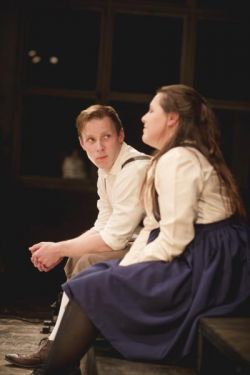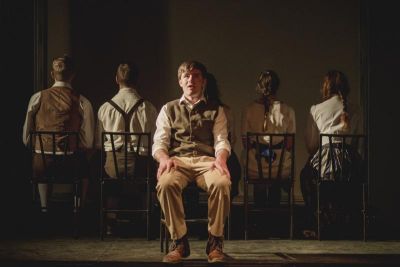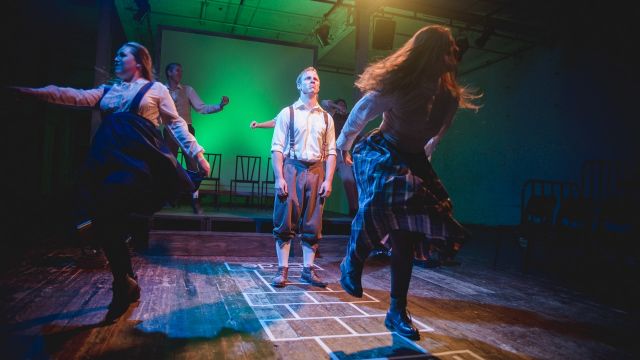Awakening
Six young actors (Nicola Dupree, Samantha Hafey-Bagg, Eamonn Johnson, James Malcher, Sam Porter and Imogen Walsh) embody the teenage characters of Daniel Lammin’s rewrite, direction and concept of Wedekind’s ‘scandalous’ 1891play, Spring Awakening. The concept gives them the challenge of switching characters from scene to scene. They begin in appropriately period Austrian school pupil costumes: knickerbockers with braces, full skirts and stout boots – but there are some deliberate anachronisms, such as ‘selfies’ on a mobile phone. Their characters experience the eruption of burgeoning sexuality while authority, in the form of parents, clergy and teachers, tries to keep them in far from blissful ignorance. But hormones and curiosity combined with shame and repression make for an unhappy mix. When 14-year-old Wendla, for example, asks her Mother where babies come from and presses for a sensible answer (‘Does the stork come down the chimney or through the window?’), the explanation is so evasive, so ludicrous – and so embarrassing – that the scene gets a big (but easy) laugh from the audience.
With the exception of Wendla’s Mother, however, adult authority characters are only referenced and otherwise have been excised from the text. But Wendla’s Mother is played by two of the cast (Nicola Dupree and Imogen Walsh), speaking simultaneously. This device, perhaps intended to suggest that this ‘Mother’ is more than one ‘Mother’ and represents the ‘standard’ Mother of the time, is indicative of the ways in which this production unfortunately keeps the audience at a distance, counter to what is undoubtedly the overall intention, affirmed so strongly in the program notes,
 Mr Lammin’s concept of his actors switching roles means it is difficult to engage with the characters – and their pain and bewilderment – with any sense of continuity and development. Tall, good-looking Sam Porter, for instance, begins as the intellectual rebel Melchior, but in his next scene is someone else (I’m afraid I lost track), and by the end is playing Moritz, the boy who succumbs to the pressures of exams and sexual confusion – and then Mr Porter is there as Melchior again attending Moritz’ funeral. Although the cast’s acting is striking, touching or funny, it is so only within single scenes and our emotional engagement dissipates when in the next scene, the actor is now playing a different character – and without a great deal of differentiation. This otherwise talented cast (who perhaps leapt at this ‘concept’ as a challenge) is in fact hampered by this directorial decision - as is the audience from engaging with them.
Mr Lammin’s concept of his actors switching roles means it is difficult to engage with the characters – and their pain and bewilderment – with any sense of continuity and development. Tall, good-looking Sam Porter, for instance, begins as the intellectual rebel Melchior, but in his next scene is someone else (I’m afraid I lost track), and by the end is playing Moritz, the boy who succumbs to the pressures of exams and sexual confusion – and then Mr Porter is there as Melchior again attending Moritz’ funeral. Although the cast’s acting is striking, touching or funny, it is so only within single scenes and our emotional engagement dissipates when in the next scene, the actor is now playing a different character – and without a great deal of differentiation. This otherwise talented cast (who perhaps leapt at this ‘concept’ as a challenge) is in fact hampered by this directorial decision - as is the audience from engaging with them.
This is a show that seems as much about ‘theatre’ – that is, theatrical devices for their own sake - and a ‘concept’ – rather then employing theatrical devices to communicate with the audience about the tribulations of youth. The intentions driving the writing and the directorial choices can be inferred, but they are abstract, or theoretical – and do they strengthen or weaken what Mr Lammin claims he wants to say?
Without wishing to compare this version line by line with Wedekind’s original, Mr Lammin’s writing itself truncates the characters’ complexity and flattens Wedekind’s story and his structure into a series of vignettes. When Melchior (or is it Moritz?) (in this particular scene played by James Malcher) and Hansy (in this scene Eamonn Johnson) hang out in the forest for some affectionate kissing and apparently guilt-free sex – all very nice, of course – the scene is illustration, not story, and nothing much happens beyond the scene itself. As if aware of all these disjunctions, Mr Lammin projects ironic intertitles between scenes.
Part Two – after an interval – has the same name characters, but now in the present, in contemporary teen garb – and begins with a rock band. In this ‘contemporary’ part, stripped of the framing distance provided by ‘period’, I think we are entitled to expect more than we get, but this second half is, really, too much like the first.
 To my surprise there is very little recognition, let alone dramatization, of the different but powerful pressures on present day teenagers and their sexuality – far more accessible experimentation and what is naively imagined as ‘information’ on the Internet. On-line pornography, ‘sexting’, ‘hooking up’ for near anonymous sex, Tinder, Grindr, the obsession – male and female – with body image, and the simplistic versions of ‘sex-ed’ that leave emotional complexity aside. Other adaptations, such as the successful 2006 Spring Awakening The Musical or Anya Reiss’ recent version in the UK, do, apparently, acknowledge – and use – these forces in their teenager characters’ lives.
To my surprise there is very little recognition, let alone dramatization, of the different but powerful pressures on present day teenagers and their sexuality – far more accessible experimentation and what is naively imagined as ‘information’ on the Internet. On-line pornography, ‘sexting’, ‘hooking up’ for near anonymous sex, Tinder, Grindr, the obsession – male and female – with body image, and the simplistic versions of ‘sex-ed’ that leave emotional complexity aside. Other adaptations, such as the successful 2006 Spring Awakening The Musical or Anya Reiss’ recent version in the UK, do, apparently, acknowledge – and use – these forces in their teenager characters’ lives.
If Wedekind’s teenagers suffer from repression and ignorance, contemporary teenagers suffer from an overload of ‘information’ and stimulation that they are ill-equipped and unhelped to handle. But here, we get not a lot more than the pressure of exams and directionless sexuality, the inability of the kids, left to their own devices, to help each other (an exchange of banal text messages between Melchior and Moritz on a screen, shown to us twice), and a rewrite of a rape scene and the aftermath that is, while worthy and correct, somewhat standard issue and not as bold or complex as Wedekind’s 1891 version. The most convincing and indeed moving scene of the second half – and for me, the whole show – is Moritz’ funeral where his friends are by turns incredulous, sad, helpless, guilty, sceptical and even indulging in a little recreational grieving. This scene has the stamp of real teens of today.
 If Spring Awakening really is a ‘timeless classic’, how much adaptation does it need? It needs to be brought into the present but it also needs to make us feel. Wedekind was clearly a compassionate but angry revolutionary, attempting to confront his audiences with the tragic consequences of enforced ignorance. This production is the second outing for Awakening. It’s first, in a smaller, more intimate venue, was warmly received and its theatrical experimentation more appreciated. On the bare fortyfivedownstairs space, the concept is rather exposed. I must say I felt for this young cast as they navigated such demanding strictures on their talent. The claims made in the program notes – that Awakening has a ‘searing message’ and that it is ‘an exorcism of demons’ – are just not achieved in this production.
If Spring Awakening really is a ‘timeless classic’, how much adaptation does it need? It needs to be brought into the present but it also needs to make us feel. Wedekind was clearly a compassionate but angry revolutionary, attempting to confront his audiences with the tragic consequences of enforced ignorance. This production is the second outing for Awakening. It’s first, in a smaller, more intimate venue, was warmly received and its theatrical experimentation more appreciated. On the bare fortyfivedownstairs space, the concept is rather exposed. I must say I felt for this young cast as they navigated such demanding strictures on their talent. The claims made in the program notes – that Awakening has a ‘searing message’ and that it is ‘an exorcism of demons’ – are just not achieved in this production.
Michael Brindley
Photographer: Theresa Harrison
Subscribe to our E-Newsletter, buy our latest print edition or find a Performing Arts book at Book Nook.

